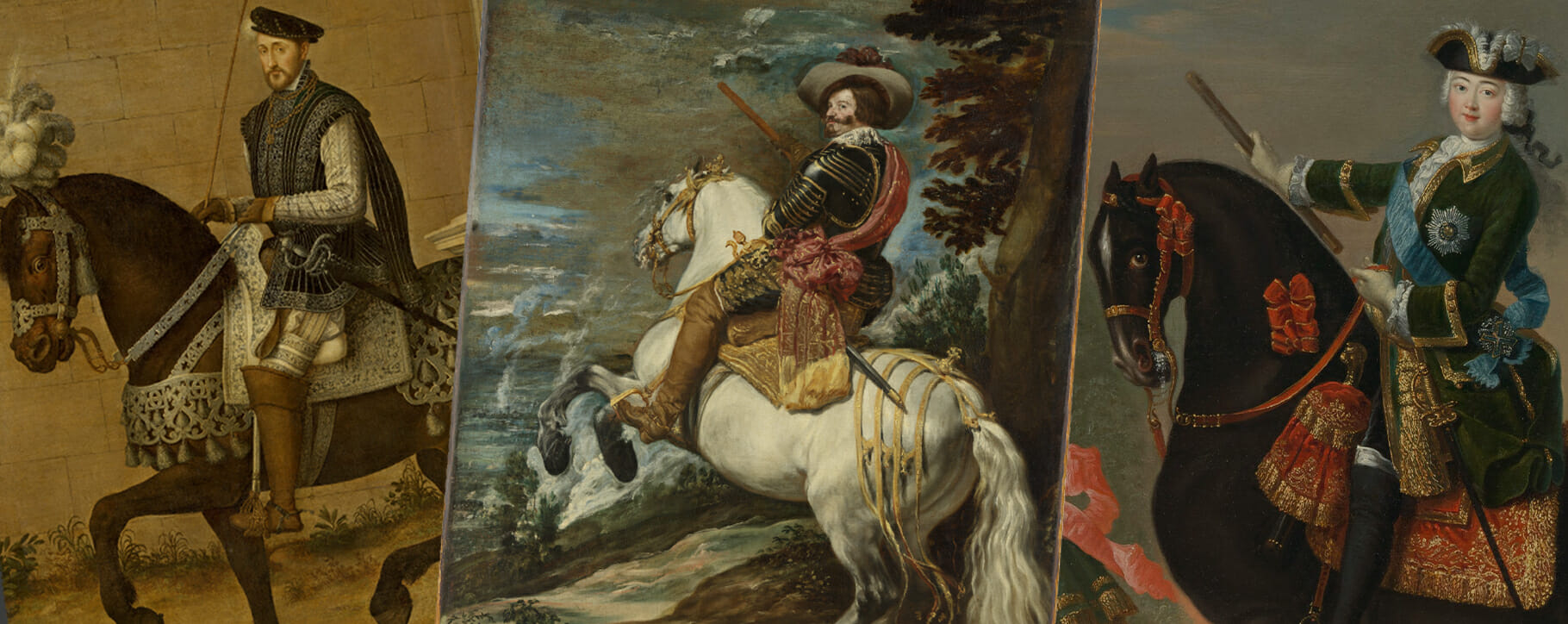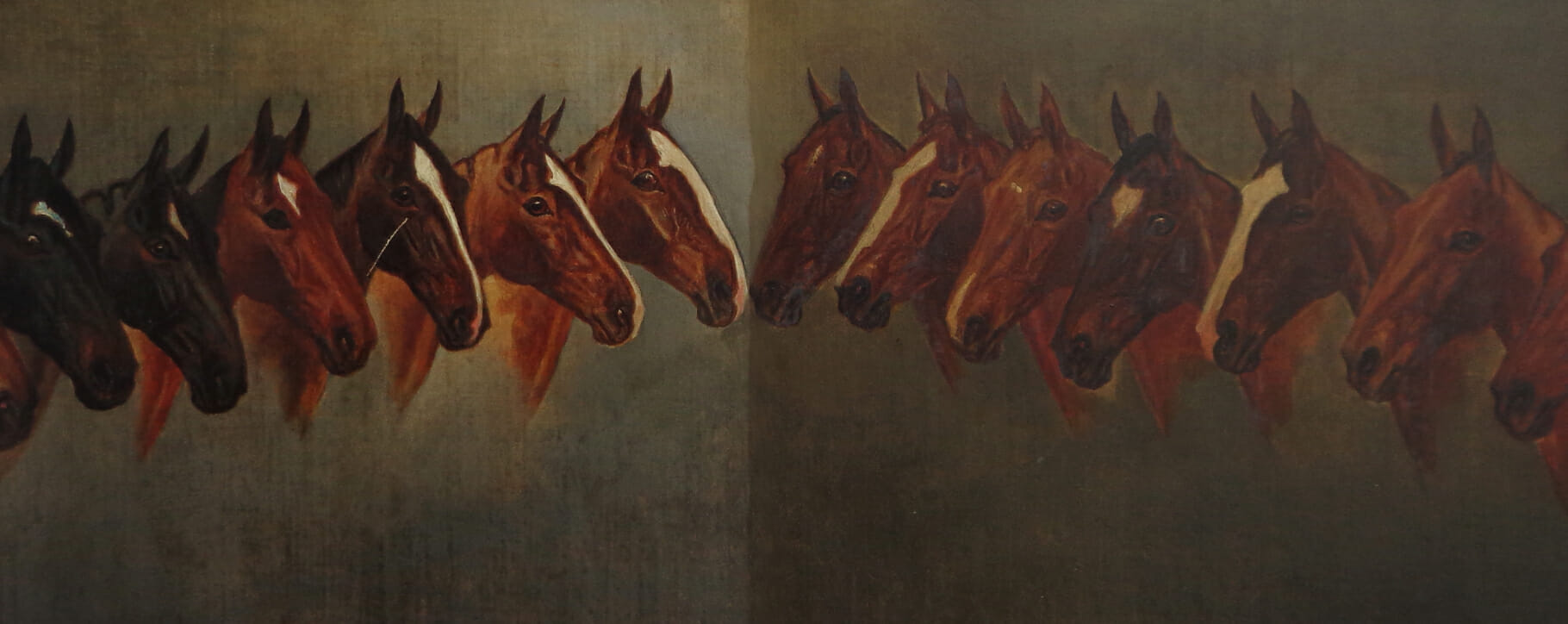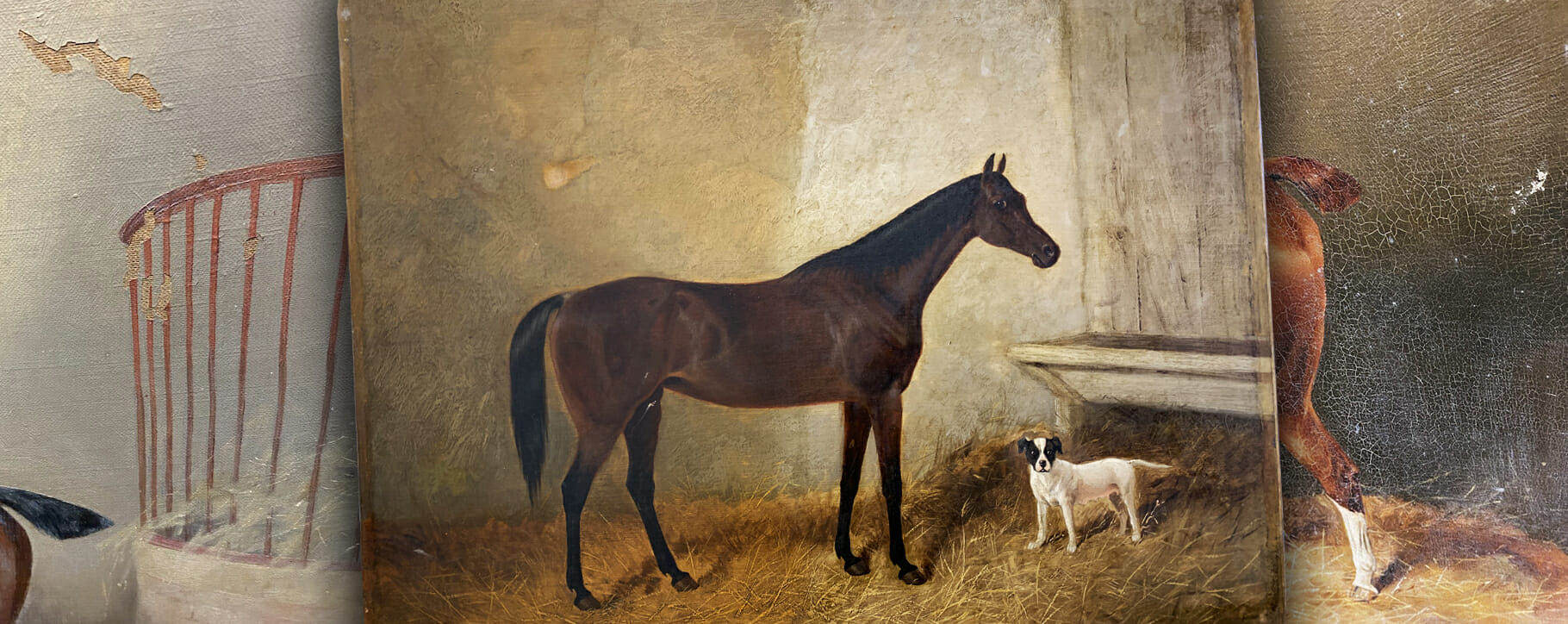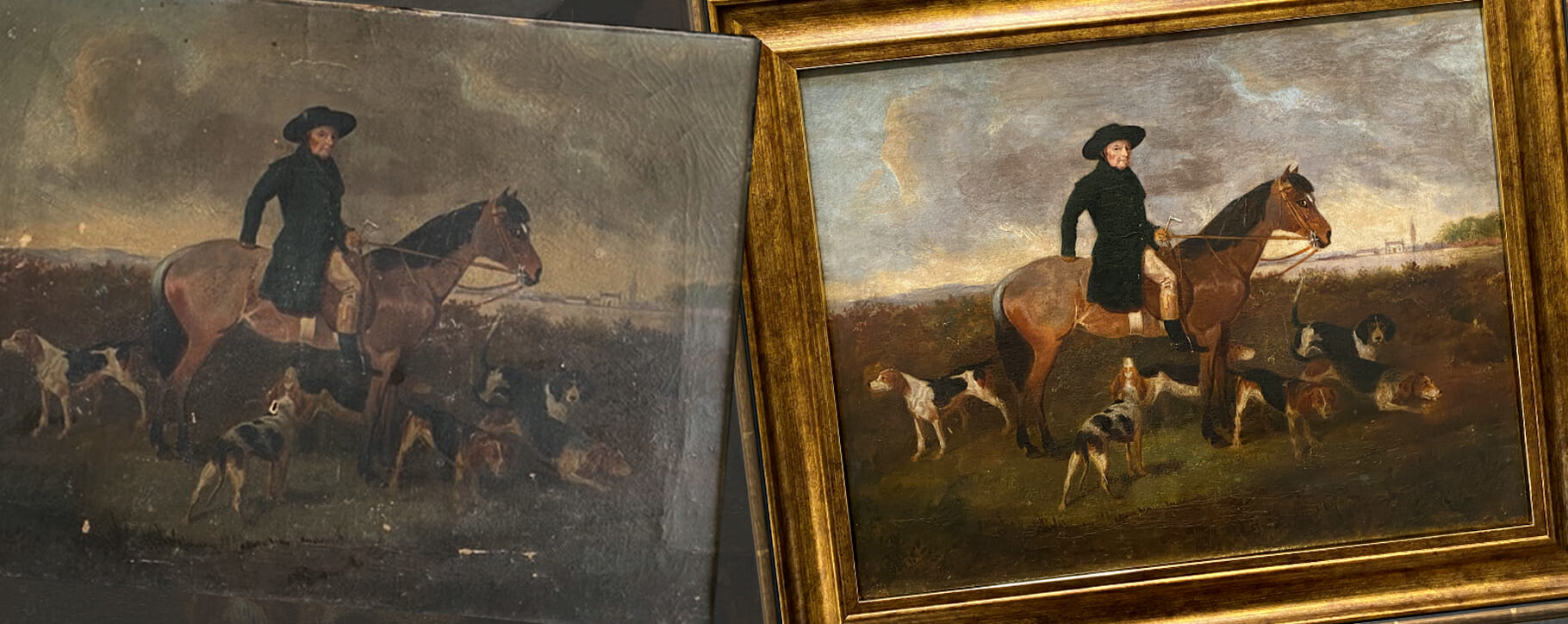Our equine friends have always been a vital part of history, in war, commerce and companionship. From the 17,000 year old Lascaux cave paintings, to the Victorian scenes of hunting and racing, horses have also been a recurrent character in art history, appearing in more paintings and sculptures than any other animal in the world.
Whilst equestrian portraits have their own genre in painting, artworks featuring a lone horse are also common. Many of these seek to commemorate a renowned racehorse or hunting partner, with as much personality and detail as a human sitter. Their popularity means that our conservators often come across these portraits in our studio, which is why we have chosen to explore horse painting restoration further.
In this article we will look into the history of horses in art, as well as the tailored conservation treatments which may be recommended when an equine portrait comes into our restoration studio.
 Above: A detail of the white horse in ‘Wolf and Fox Hunt’ by Peter Paul Rubens, 1616
Above: A detail of the white horse in ‘Wolf and Fox Hunt’ by Peter Paul Rubens, 1616
The symbolism of horses in art history
Culturally, horses were an important part of ancient history. Not only were they an enduring part of economy and travel, but worked to pull the chariots of both powerful men and gods. In Greek mythology the chariot of Helios was pulled by four white horses, who travelled from east to west across the sky to rise and set the sun. Whilst the mares of Diomedes were a subject of horror, these man-eating beasts were seen as wild and uncontrolled. Horses were both a symbol of man’s dominance over nature, and the still untamed areas which had a romantic magnificence.
 Above: an architrave with sculpted metope of the sun god Helios and his horses from temple of Athena at Troy, 300-280 BCE
Above: an architrave with sculpted metope of the sun god Helios and his horses from temple of Athena at Troy, 300-280 BCE
In ancient Rome the practice of bronze statues depicting emperors on horseback became symbolic of their military power and the hold over the empire. Not only did it give them extra height in their appearance, but a strength that was beyond their human capability. Later, as Christianity began to dominate Europe, depictions of horses grew less frequent until the artistic revolution of the renaissance.
 Above: prints featuring an equestrian statue of the Roman Emperor Tiberius and an equestrian statue of King Henry II of France
Above: prints featuring an equestrian statue of the Roman Emperor Tiberius and an equestrian statue of King Henry II of France
By the 16th century, there was a resurgence of the powerful themes of Roman bronzes, with commissions of sitters on horseback in both paintings and sculptures. A knowledge of ancient Rome and its late leaders gave important connotations to equestrian artworks. The strength presented in the portraits of Titian and the later baroque pieces of Rubens and Velazquez, show not only a present influence, but ties to great powers of the past through this cultural hint towards ancient empires.
Across Europe there was a perception that royal dominance was inherited from the glory of past leaders, especially that of famous figures such as Charlemagne. This further fueled the desire for such an association in their equestrian portraits, whether or not the sitter was a skilled rider. In such paintings where the horse is rearing and wild, symbolism also exists of the patron’s ability to control and conquer nature, even in its most challenging form.
 Above: equestrian portraits by François Clouet (16th century), Velázquez (17th century), Georg Christoph Grooth (18th century)
Above: equestrian portraits by François Clouet (16th century), Velázquez (17th century), Georg Christoph Grooth (18th century)
Famous horses in art history
- The Roman bronze equestrian statue of Marcus Aurelius was also spared from destruction as it was confused for a depiction of the first Christian emperor Constantine.
- Rosa Bonheur disguised herself a man to paint her masterpiece ‘The Horse Fair’ in the 1850s.
- Homer’s Iliad famously describes the victory over Troy through the use of a giant wooden horse. This scene has inspired many artists and writers, sketches depicting the scene by Giovanni Domenico Tiepolo are part of the National Gallery’s main collection.
- Napoleon Crossing the Alps by Jacques-Louis David is one of the most famous portraits of the emperor. The symbolism of ancient equestrian statues and wild nature of the horse (held by just one hand) is easily able display his power.
- Salvador Dali’s Debris of an Automobile Giving Birth to a Blind Horse Biting a Telephone is a nightmarish array of technological advancements.
- Conversion On The Way To Damascus by Caravaggio was painted in 1601 for the church of Santa Maria del Popolo in Rome. It depicts the conversion of Paul, who on his way to persecute Christians falls off of his horse and hears the words of Jesus. Even though the biblical text does not mention a horse, Caravaggio has chosen to use the animal as a central feature.
 Above: a close up of The Horse Fair by Rosa Bonheur, 1852-55
Above: a close up of The Horse Fair by Rosa Bonheur, 1852-55
Horse portraits
As an economic pursuit, many artists had specialist commercial areas to ensure their income. George Stubbs is one of the most famous horse portraitists, finding a niche in the market after meticulously studying the anatomy of horses prior to his artistic endeavours. This attention to detail and marketable approach gave Stubbs a wide circle of patrons, eager to commemorate their horses.
Horse portraits have less symbolic reach towards ancient power, but instead a display of wealth and adoration of the creature as personal property. Just as a landowner may commission a painting of their estate, the depiction of a horse reflects a similar economic status. As the middle classes grew from the 18th century onwards, the ability to afford a horse which was not just for labour became obtainable and fashionable. A well-bred horse not only displayed social status, but gained access to high society pursuits such as racing, polo, and cross country hunts. As vital companions in the wars of the 18th and 19th centuries, a soldier may have also commemorated the steed which had served him whilst in service. These horses often retired, but remained an important part of their owner’s life and could themselves be seen as heroes.
 Above: horse paintings by George Stubbs, including his masterpiece Whistlejacket (centre)
Above: horse paintings by George Stubbs, including his masterpiece Whistlejacket (centre)
Stubb’s most famous work is Whistlejacket from 1762, housed in The National Gallery, London. This racehorse with a shining coat is seen as an exemplary display of both the artist’s anatomical knowledge and the thoroughbred beauty. The painting was revolutionary as a piece which focuses solely on the horse, with no landscape or figures to distract from its presence. It was also a challenge to the hierarchy of painting, this is the concept that there are differing levels of skill and artistic genius, with ‘history painting’ at the top (mythological, imaginative scenes) and simplistic paintings of still life, landscapes and animals at the bottom. The grandeur of Whistlejacket allows the horse portrait to stand proudly alongside the traditional forms of high art.
 Above: a unique group portrait of horses halfway through a treatment by our conservators to remove smoke damage and contamination
Above: a unique group portrait of horses halfway through a treatment by our conservators to remove smoke damage and contamination
The practice of horse portraiture, as well as horses in art generally, began to decline as the 20th century progressed and horses became less of a necessity in everyday life. Henry Frederick Lucas-Lucas still practiced the genre of horse portraiture until the 1940s, capturing the likeness of racehorses which may have been difficult to photograph or otherwise commemorate. However, you may still come across horses and their powerful symbolism in renowned modern art, such as Pablo Picasso’s Guernica.
Restoring horse portraits
Oil paintings on panels and canvas face issues from their environment and accidental damage. An average restoration may consist of a varnish removal to clear away contamination and discoloured historic varnish, followed by a replacement of a UV protective non-yellowing variety. Whilst a more intense level of treatment may involve the sensitive retouching of missing paint, repair of torn or dented areas, re-tensioning, mould removal, or canvas relining. Restoration following disasters such as flooding or fires may also occur, using specialist methods to save the art from deterioration and loss.
Our expert conservators are trained in all manner of easel paintings, from the middle ages through to contemporary. Many of them are especially well-versed in the structure and requirements of paintings from the 18th and 19th centuries, from which many horse portraits will be dated.
 Above: a turn of the century horse painting before and after a surface clean and varnish removal by our team
Above: a turn of the century horse painting before and after a surface clean and varnish removal by our team
The artwork of Henry Frederick Lucas-Lucas is a frequent guest in our studio. This is partly due to the proliferation of his portraits on a commercial scale, which have found themselves in many collections and private homes throughout the United Kingdom. Another reason for this is the original materials used in his paintings, including a now discoloured historic varnish. The era of the portraits, and the environments they may have been displayed in over the following decades, would have also exposed them to higher levels of nicotine and fireplace soot as indoor smoking and open fires were more commonplace.
 Above: examples of common flaking paint and cracking found on a Lucas Lucas horse portrait, in the centre you can see a painting halfway through a varnish removal which reveals the original colours
Above: examples of common flaking paint and cracking found on a Lucas Lucas horse portrait, in the centre you can see a painting halfway through a varnish removal which reveals the original colours
Therefore, the most common restoration treatment is the removal of contamination and the discoloured varnish layer. This is achieved through small and precise swabs with a tailored solvent solution. The tailoring of the solvent ensures that whilst the varnish is removed, the original paint layer is not affected. If there are any areas of over-painting from past restorations or unoriginal edits from past owners, these will also be replaced with safe techniques. New conservation-grade varnish will then coat the piece, before any areas which may require re-touching are carefully colour-matched for a seamless finish.
 Above: a hunting portrait with tears, flaking paint and discolouration before and after restoration by our team of conservators
Above: a hunting portrait with tears, flaking paint and discolouration before and after restoration by our team of conservators
Our conservators find that Lucas-Lucas horse portraits have a very thin paint and varnish layer. This can lead to delamination of the varnish in some areas, giving an uneven and distracting finish. This may also lead to the thin paint layer being uncovered and unprotected, creating flaking and loss of colour. Any pigments used by our conservators to correct these areas are fully reversible, so that in the future this intervention will not be confused for the original artwork. This is important for later restoration treatments or during valuation and historical analysis. Retouching is also important to not only return the visual impact, but in helping to stabilise the paint layer and cover any bare canvas which may be otherwise left vulnerable to deterioration.
 Above: this horse painting had an amateur restoration attempt at home, which damaged it further (left) our team then reversed this and provided professional treatments (right)
Above: this horse painting had an amateur restoration attempt at home, which damaged it further (left) our team then reversed this and provided professional treatments (right)
The finished restoration returns the piece to its original state, with bright original tones in the horse’s thoroughbred coat, as well as in the sky and landscape beyond. The stabilisation of the painting will help it to survive for decades to come, with lowered risks of loss and decay.
Contact our team for further information
If you have a horse portrait or any oil painting in mind for conservation, please contact our team for swift and insightful advice.
You can contact us via email [email protected] or telephone 0207 112 7576

 Above: A detail of the white horse in ‘Wolf and Fox Hunt’ by Peter Paul Rubens, 1616
Above: A detail of the white horse in ‘Wolf and Fox Hunt’ by Peter Paul Rubens, 1616 Above: an architrave with sculpted metope of the sun god Helios and his horses from temple of Athena at Troy, 300-280 BCE
Above: an architrave with sculpted metope of the sun god Helios and his horses from temple of Athena at Troy, 300-280 BCE Above: prints featuring an equestrian statue of the Roman Emperor Tiberius and an equestrian statue of King Henry II of France
Above: prints featuring an equestrian statue of the Roman Emperor Tiberius and an equestrian statue of King Henry II of France Above: equestrian portraits by François Clouet (16th century), Velázquez (17th century), Georg Christoph Grooth (18th century)
Above: equestrian portraits by François Clouet (16th century), Velázquez (17th century), Georg Christoph Grooth (18th century) Above: a close up of The Horse Fair by Rosa Bonheur, 1852-55
Above: a close up of The Horse Fair by Rosa Bonheur, 1852-55 Above: horse paintings by George Stubbs, including his masterpiece Whistlejacket (centre)
Above: horse paintings by George Stubbs, including his masterpiece Whistlejacket (centre) Above: a unique group portrait of horses halfway through a treatment by our conservators to remove smoke damage and contamination
Above: a unique group portrait of horses halfway through a treatment by our conservators to remove smoke damage and contamination Above: a turn of the century horse painting before and after a surface clean and varnish removal by our team
Above: a turn of the century horse painting before and after a surface clean and varnish removal by our team Above: examples of common flaking paint and cracking found on a Lucas Lucas horse portrait, in the centre you can see a painting halfway through a varnish removal which reveals the original colours
Above: examples of common flaking paint and cracking found on a Lucas Lucas horse portrait, in the centre you can see a painting halfway through a varnish removal which reveals the original colours Above: a hunting portrait with tears, flaking paint and discolouration before and after restoration by our team of conservators
Above: a hunting portrait with tears, flaking paint and discolouration before and after restoration by our team of conservators Above: this horse painting had an amateur restoration attempt at home, which damaged it further (left) our team then reversed this and provided professional treatments (right)
Above: this horse painting had an amateur restoration attempt at home, which damaged it further (left) our team then reversed this and provided professional treatments (right)




